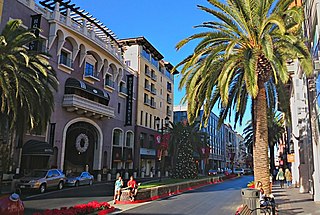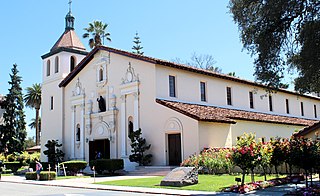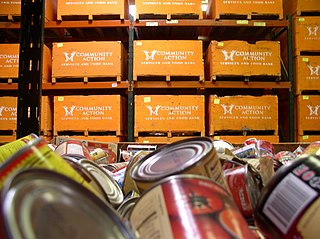
San Jose, officially the City of San José, is the largest city in Northern California by both population and area. With a 2022 population of 971,233, it is the most populous city in both the Bay Area and the San Jose–San Francisco–Oakland Combined Statistical Area—which in 2022 had a population of 7.5 million and 9.0 million respectively—the third-most populous city in California after Los Angeles and San Diego, and the 13th-most populous in the United States. Located in the center of the Santa Clara Valley on the southern shore of San Francisco Bay, San Jose covers an area of 179.97 sq mi (466.1 km2). San Jose is the county seat of Santa Clara County and the main component of the San Jose–Sunnyvale–Santa Clara Metropolitan Statistical Area, with an estimated population of around two million residents in 2018.

Cupertino is a city in Santa Clara County, California, United States, directly west of San Jose on the western edge of the Santa Clara Valley with portions extending into the foothills of the Santa Cruz Mountains. The population was 60,381 as of the 2020 census. The city is widely known for being the home of Apple Inc., headquartered within the city at Apple Park.

Santa Clara is a city in Santa Clara County in the state of California. The city's population was 127,647 at the 2020 census, making it the eighth-most populous city in the Bay Area. Located in the southern Bay Area, the city was founded by the Spanish in 1777 with the establishment of Mission Santa Clara de Asís under the leadership of Junípero Serra.

The Santa Clara Valley is a geologic trough in Northern California that extends 90 miles (140 km) south–southeast from San Francisco to Hollister. The longitudinal valley is bordered on the west by the Santa Cruz Mountains and on the east by the Diablo Range; the two coastal ranges meet south of Hollister. The San Francisco Bay borders the valley to the north, and fills much of the northern third of the valley. The valley floor is an alluvial plain that formed in the graben between the San Andreas Fault to the west and the Hayward and Calaveras faults to the east. Within the valley and surrounding the bay on three sides are the urban communities of San Mateo County, Santa Clara County, and Alameda County, while the narrow southern reaches of the valley extend into rural San Benito County to Hollister. In practical terms, the central portion of the Santa Clara Valley is often considered by itself, contained entirely within Santa Clara County.

The Santa Clara Valley Transportation Authority, more commonly known simply as the Valley Transportation Authority (VTA), is a special district responsible for public transit services, congestion management, specific highway improvement projects, and countywide transportation planning for Santa Clara County, California. It serves San Jose, California, and the surrounding Silicon Valley. It is one of the governing parties for the Caltrain commuter rail line that serves the county. In 2023, the VTA's public transportation services had a combined ridership of 26,610,000, or about 94,100 per weekday as of the third quarter of 2024.
The basic needs approach is one of the major approaches to the measurement of absolute poverty in developing countries globally. It works to define the absolute minimum resources necessary for long-term physical well-being, usually in terms of consumption goods. The poverty line is then defined as the amount of income required to satisfy the needs of the people. The "basic needs" approach was introduced by the International Labour Organization's World Employment Conference in 1976. "Perhaps the high point of the WEP was the World Employment Conference of 1976, which proposed the satisfaction of basic human needs as the overriding objective of national and international development policy. The basic needs approach to development was endorsed by governments and workers' and employers' organizations from all over the world. It influenced the programmes and policies of major multilateral and bilateral development agencies, and was the precursor to the human development approach."

Santa Barbara, officially the Municipality of Santa Barbara, is a municipality in the province of Pangasinan, Philippines. According to the 2020 census, it has a population of 92,187 people.

The economy of the State of California is the largest in the United States, with a $4.080 trillion gross state product (GSP) as of 2024. It is the largest sub-national economy in the world. If California were a nation it would rank in terms of nominal GDP as the List of countries by GDP World's fourth largest economy, behind Germany and ahead of the Japan. Additionally, California's Silicon Valley is home to some of the world's most valuable technology companies, including Apple, Alphabet, and Nvidia. In total, 8 of the Fortune 100 companies and 57 of the Fortune 500 companies are headquartered in California. As of 2024, California is home to the most Fortune 500 companies of any U.S. state.
Silicon Valley Power (SVP) is a not-for-profit municipal electric utility owned and operated by the City of Santa Clara, California, United States. SVP provides electricity service to approximately 55,116 residential and business customers, including large corporations such as Intel, Applied Materials, Owens Corning and NVIDIA. SVP also owns and maintains a dark fiber network named SVP Fiber Enterprise.

The Santa Clara County Library District is a public library system for Santa Clara County headquartered in Campbell, California. The library serves the communities and cities of Campbell, Cupertino, Gilroy, Los Altos, Los Altos Hills, Milpitas, Monte Sereno, Morgan Hill, Saratoga, and all unincorporated areas of Santa Clara County. Other cities in Santa Clara County run their own library systems. In addition to these libraries, the library provides mobile library service with a bookmobile which visits preschools, retirement communities, migrant farmworker camps, and rural communities without easy access to library services. In 2020, SCCLD also launched a new website featuring a 24/7 online library.

David Dominic Cortese is an elected official from San Jose, California. He is currently serving in the California State Senate, representing District 15, which encompasses a majority of Santa Clara County. Before being elected to the California State Senate, Cortese served on the Santa Clara County Board of Supervisors for 12 years, as a Councilmember and Vice Mayor for the City of San Jose for eight years, and for eight years as a trustee for the East Side Union High School District in San Jose. Cortese ran for mayor of San Jose and won the primary, losing the general election to District 3 councilmember Sam Liccardo.
In the United States and its territories, Community Action Agencies (CAA) are local private and public non-profit organizations that carry out the Community Action Program (CAP), which was founded by the 1964 Economic Opportunity Act to fight poverty by empowering the poor as part of the War on Poverty.

Proposition 218 is an adopted initiative constitutional amendment which revolutionized local and regional government finance and taxation in California. Named the "Right to Vote on Taxes Act," it was sponsored by the Howard Jarvis Taxpayers Association as a constitutional follow-up to the landmark property tax reduction initiative constitutional amendment, Proposition 13, approved in June 1978. Proposition 218 was approved and adopted by California voters during the November 5, 1996, statewide general election.
San Jose, California, is the third largest city in the state, and the largest of all cities in the San Francisco Bay Area and Northern California, with a population of 1,021,795.
Santa Clara County, California, is one of California's original counties, with prior habitation dating from prehistory to the Alta California period.

Community Action Services and Food Bank (CASFB), located in Provo, Utah, is a non-profit organization that serves the low-income population of Utah, Summit, and Wasatch counties and focuses on the operation of programs that help alleviate poverty. It was founded in 1967 following the signing of the Economic Opportunity Act in 1964 by President Lyndon B. Johnson and is one of more than 1,000 independent Community Action Agencies across the country. It is sponsored by United Way of Utah County.

Santa Clara County, officially the County of Santa Clara, is the sixth-most populous county in the U.S. state of California, with a population of 1,936,259 as of the 2020 census. Santa Clara County and neighboring San Benito County form the San Jose–Sunnyvale–Santa Clara metropolitan statistical area, which is part of the larger San Jose–San Francisco–Oakland combined statistical area. Santa Clara is the most populous county in the San Francisco Bay Area and in Northern California.
The Silicon Valley BART extension is an ongoing effort to expand the Green and Orange Line service by Bay Area Rapid Transit (BART) into Santa Clara County via the East Bay from its former terminus at the Fremont station in Alameda County. Planned since at least 1981, the project has seven stations in three sequential phases.

Second Harvest of Silicon Valley is a food bank based in San Jose, California, that serves Santa Clara and San Mateo counties, including Silicon Valley and the San Francisco Peninsula. With $136 million in revenue in 2019, it is the largest food bank in the San Francisco Bay Area and the 12th largest in the United States. As of 2020, it serves about 500,000 people on average per month. It is affiliated with Feeding America, a national network of food banks, as well as the California Association of Food Banks. Leslie Bacho is the organization's chief executive officer.

The Orange County Rescue Mission (OCRM) is a faith-based, 501(c)(3) nonprofit focused on reducing homelessness. Headquartered in Tustin, California, OCRM operates multiple programs on nine campuses throughout Orange County to help people move from homelessness to self-sufficiency. OCRM supports homeless men, women, and families with housing, food, clothing, counseling, job training, medical care, dental care, psychological care, and spiritual support. Many OCRM programs are tailored for veterans, families, youth, victims of domestic violence, and victims of sex trafficking. OCRM residents are referred to as "students" as they progress through a structured, milestone-based curriculum. All programs and services are free to OCRM students.












